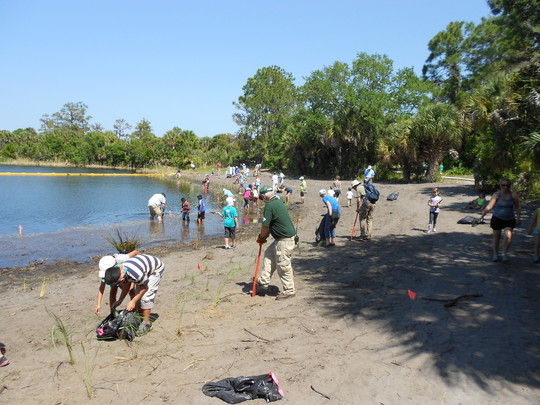FOR IMMEDIATE RELEASE: Sept. 15, 2014
SOUTH
CREEK RESTORATION PROJECT COMPLETED AT OSCAR SCHERER STATE PARK
 The tidal creek was restored along with two lakes and a wetlands area.
OSPREY – The Florida
Department of Environmental Protection’s Division of Recreation and Parks has
partnered with the Sarasota Bay Estuary Program to restore and enhance the
historic wetlands found at Oscar Scherer State Park in Osprey, south of
Sarasota. A grant for $105,000 was secured from the South West Florida Water
Management District to fund the construction, which started in March 2014.
Volunteers will complete the restoration on Sept. 27 during National Public
Lands Day activities.
South
Creek is a tidal creek that flows through Oscar Scherer State Park. The
wetlands surrounding South Creek have been impacted over the years by
development and drainage activities. The project recreated the wetlands and
enhanced already existing wetlands by removing exotic and nuisance species, regrading
steep slopes within the onsite borrow pit and main lake system, and planting
native wetland species.
“Under normal circumstances, bull dozers just push dirt
around,” said Donald Forgione, director of the Florida Park Service. “However,
this time, the bulldozers are tools used to create better places for swimming
and fishing. The project built better habitat for a variety of animals like
bullfrogs, great blue herons and egrets.”
In addition, a former isolated wetland was restored to provide
critical wildlife habitat. This project enhances water quality by providing
nutrient uptake prior to discharging into South Creek and eventually Sarasota
Bay.
“Volunteers played a vital part in this project,” said Tony
Clements, park manager at Oscar Scherer State Park. “We tied the plantings at
Lake Osprey into our Earth Day event. Hundreds of people helped plant more than 9,000 plants in four hours in the shallow waters and bank of the lake. Phase II
of the volunteer efforts will take place Sept. 27 at the annual National Public
Lands Day event. Volunteers will open up access for fishing and shady spots for
visitors to enjoy.”
This
restoration project consisted of three separate areas. The first area, Lake
Osprey, is a freshwater man-made borrow pit dug in the 1960s. Since 1965, swimming has been
allowed on the western side and fishing has been allowed on the
eastern bank. This project removed the steep banks along the eastern shore by
digging the shoreline back and pushing some of the material back into the lake.
All the nuisance cattails were removed from the lake. More natural littoral
shelves were created along the eastern bank with plantings of native plant
species, which will better serve native animal and plant species.
Big
Lake is a second freshwater man-made borrow pit dug in the 1960s. This lake is
located along the five-mile yellow trail. Anglers enjoy this lake that has an
observation deck on the north corner. This project removed the steep banks
along the north and south shores by digging back the shoreline and filling in
some of the lake to create a more natural shoreline. Littoral shelves were created
with plantings of native plant species. Nuisance cattails were removed from the
sections of the restored lake.
Wetland
3A was altered in the early 1960s. The project restored the natural slope and
flow to the wetland, including the planting of more wetland endemic plant
species.
Within
days of project completion, more than 10 different species of birds never seen
at Big Lake were found utilizing this newly restored habitat. For the first
time, roseate spoonbills, great blue herons, white egrets, anhinga, little blue
herons and wood storks were seen foraging in the shallows of the lakes.
The
Friends of Oscar Scherer Park, Inc. have set aside $90,000 to fund an
accessible fishing dock, dip netting programs and improved access to Lake
Osprey.
|